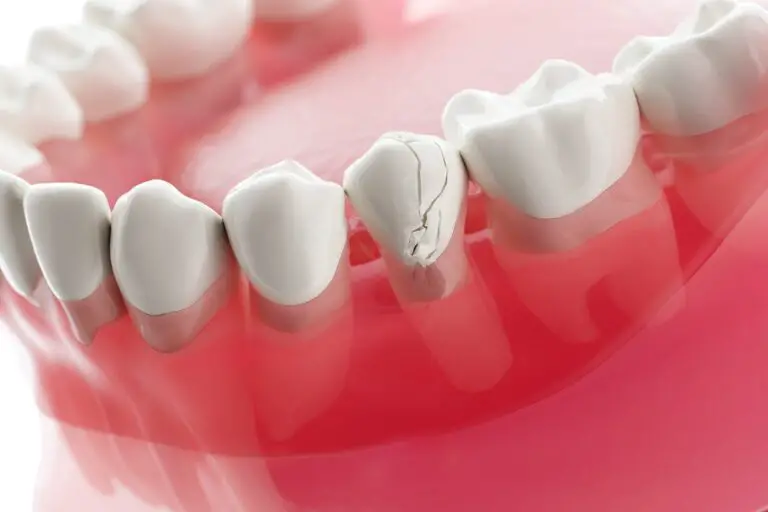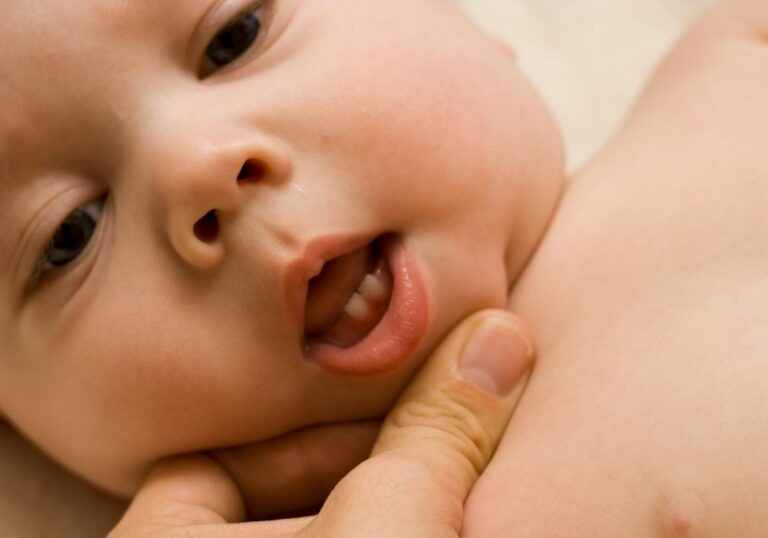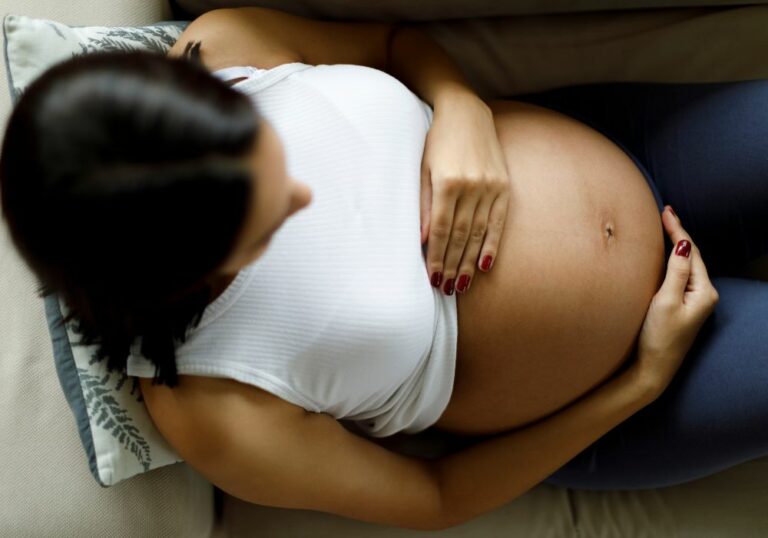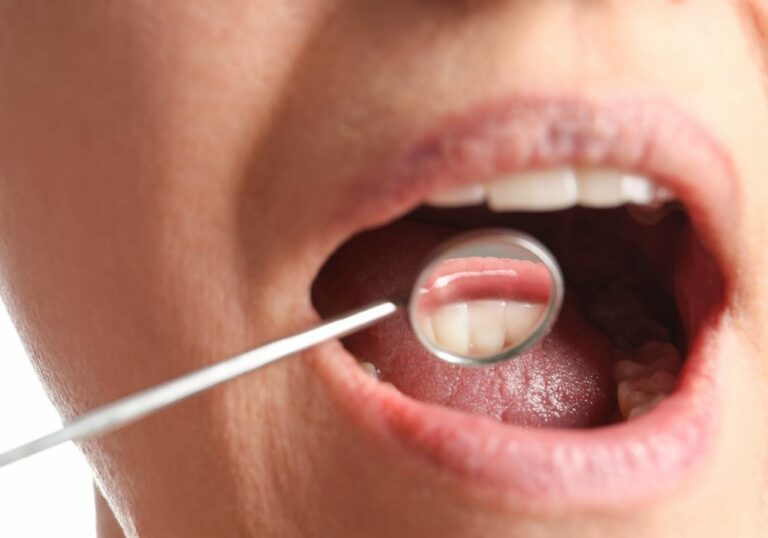Are you wondering if you can see your baby’s teeth through the front of their gums? The answer is yes. Before teeth emerge, you can often see signs of teeth under the gums. Look for white spots or bumps along the gums, especially along the bottom front gums. The whitish color comes from calcium deposits collecting under the gums where teeth are beginning to develop.
While teething can begin as early as 3 months, most likely you’ll see the first tooth start pushing through your baby’s gum line when your little one is between 4 and 7 months old. The first teeth to appear usually are the two bottom front teeth, also known as the central incisors. As you can see from the teething chart, it’s usually the two front teeth on the bottom that come in first. Your baby’s gums may be swollen and red where the teeth are coming through, and your little one may have other teething symptoms.
Teething can cause pain and discomfort in babies, so it’s important to know what to expect. In this article, we will discuss what a baby’s gums look like while teething, the order in which teeth come in, and how to soothe your baby’s teething pain. By the end of this article, you’ll have a better understanding of what to expect when your baby starts teething and how to help them through the process.
Understanding Baby Teeth Development
As a new parent, it’s important to understand the development of your baby’s teeth. This will help you know what to expect and how to provide the best care for your little one. Here are some key things to know about baby teeth development.
Stages of Baby Teeth Development
Baby teeth development begins before your baby is even born. At around six weeks of pregnancy, the basic substance of the tooth forms. By the time your baby is born, around 20 tooth buds have already formed, which will eventually erupt into primary teeth.
The development of baby teeth occurs in stages. The first stage is the formation of the basic substance of the tooth. The second stage is the formation of the hard tissue that surrounds the teeth, which occurs around three to four months of gestation. The third stage is the formation of the roots of the teeth, which occurs after the teeth have erupted through the gums.
Signs of Teething
Teething is the process of teeth growing and breaking through the gums, and it can cause pain and discomfort for your baby. Some signs of teething include fussiness, drooling, chewing on objects, and swollen gums. You may also notice that your baby’s appetite changes during this time.
It’s important to provide your baby with relief during the teething process. You can try giving your baby a clean, chilled teething ring or a damp washcloth to chew on. You can also gently massage your baby’s gums with a clean finger.
In conclusion, understanding baby teeth development is important for new parents. Knowing the stages of development and signs of teething can help you provide the best care for your little one during this important time.
Can You See Baby’s Teeth Through Front of Gums
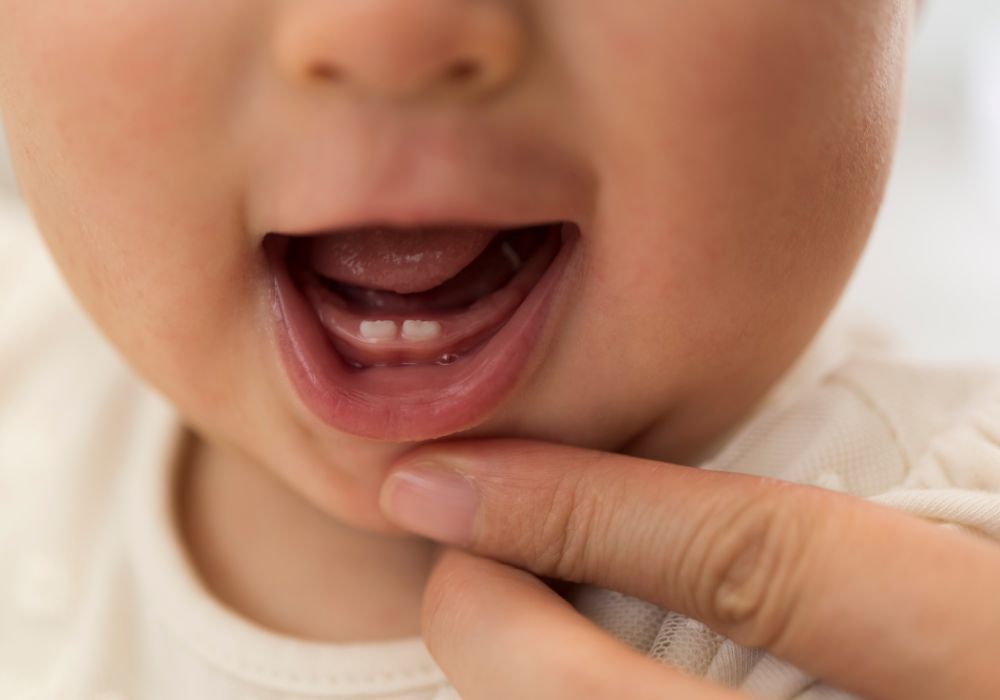
If you’re wondering whether you can see your baby’s teeth through the front of their gums, the answer is yes. Teeth start to develop under the gums before they emerge, and there are visual and physical indicators that can help you determine if your baby’s teeth are starting to come in.
Visual Indicators
One way to tell if your baby’s teeth are starting to come in is by looking for white spots or bumps along the gums. These spots are caused by calcium deposits that collect under the gums where teeth are beginning to develop. You may also notice that your baby’s gums look swollen or red in the area where the teeth are coming in.
Physical Indicators
In addition to visual indicators, there are physical indicators that can help you determine if your baby’s teeth are starting to come in. Your baby may start to drool more than usual and want to chew on things to relieve the discomfort. You may also notice that your baby is more irritable than usual or has trouble sleeping.
As your baby’s teeth continue to come in, you may notice that they start to become more visible through the front of the gums. This is a sign that the teeth are getting ready to emerge. Eventually, you will be able to see the entire tooth through the gums.
If you’re concerned about your baby’s teeth or have questions about teething, be sure to talk to your pediatrician or dentist. They can provide you with more information and help you determine if your baby’s teeth are developing normally.
Common Misconceptions About Baby Teething
Teething is a natural process that every baby goes through, but there are many misconceptions about it. Here are some common misconceptions about baby teething that you should be aware of:
- Misconception #1: Teething causes fever. While it’s true that some babies may experience a slight increase in body temperature while teething, it’s not a fever. A fever is a temperature of 100.4°F (38°C) or higher, and teething does not cause a fever of this magnitude. If your baby has a fever, it’s likely due to an infection or illness and you should consult a doctor.
- Misconception #2: Teething causes diarrhea. Teething does not cause diarrhea. However, some babies may experience loose stools while teething due to increased drooling and swallowing of saliva. If your baby has persistent diarrhea, it’s important to consult a doctor.
- Misconception #3: Teething causes ear infections. While it’s true that some babies may pull on their ears while teething, teething itself does not cause ear infections. Ear infections are typically caused by bacteria or viruses and require medical treatment.
- Misconception #4: Teething causes sleep problems. Teething can cause some babies to have trouble sleeping due to discomfort or pain, but it’s not the only cause of sleep problems. If your baby is having persistent sleep issues, it’s important to consult a doctor.
- Misconception #5: Teething starts at a specific age. While most babies start teething around 6 months of age, some babies may start earlier or later. The timing of teething can vary widely from baby to baby.
It’s important to remember that every baby is different and may experience teething differently. If you have concerns about your baby’s teething, it’s always best to consult a doctor.
How to Soothe Teething Babies
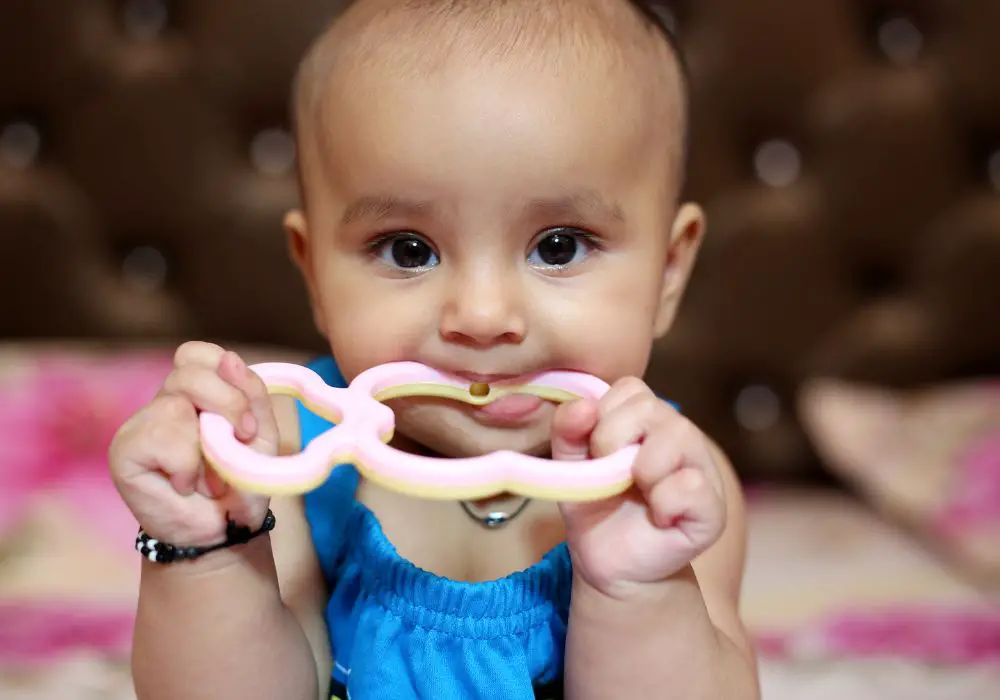
Teething can be a difficult time for both babies and parents. Fortunately, there are several ways to help soothe your baby’s sore gums and make the process a little bit easier. Here are some safe and effective methods to try:
Safe Teething Toys
Giving your baby a teething toy can be a great way to provide relief. Look for toys that are specifically designed for teething, with soft and flexible materials that are safe for your baby to chew on. Some popular options include:
- Silicone teething rings
- Rubber teethers
- Wooden teethers
Be sure to choose toys that are free from harmful chemicals and are easy to clean. You can also try refrigerating or freezing the toys for added relief.
Home Remedies
There are several home remedies that can help soothe your baby’s teething pain. Here are a few to consider:
- Rubbing your baby’s gums with a clean finger or a damp washcloth
- Massaging your baby’s gums with a clean, chilled spoon
- Offering your baby a chilled, damp washcloth to chew on
- Giving your baby a chilled, mashed fruit or vegetable to eat
It’s important to note that while home remedies can be effective, they should never be used as a substitute for medical care. If your baby is experiencing severe pain or other symptoms, be sure to consult with your pediatrician.
Overall, teething can be a challenging time for both babies and parents, but with the right tools and techniques, you can help soothe your little one’s sore gums and make the process a little bit easier.
When to Consult a Pediatric Dentist
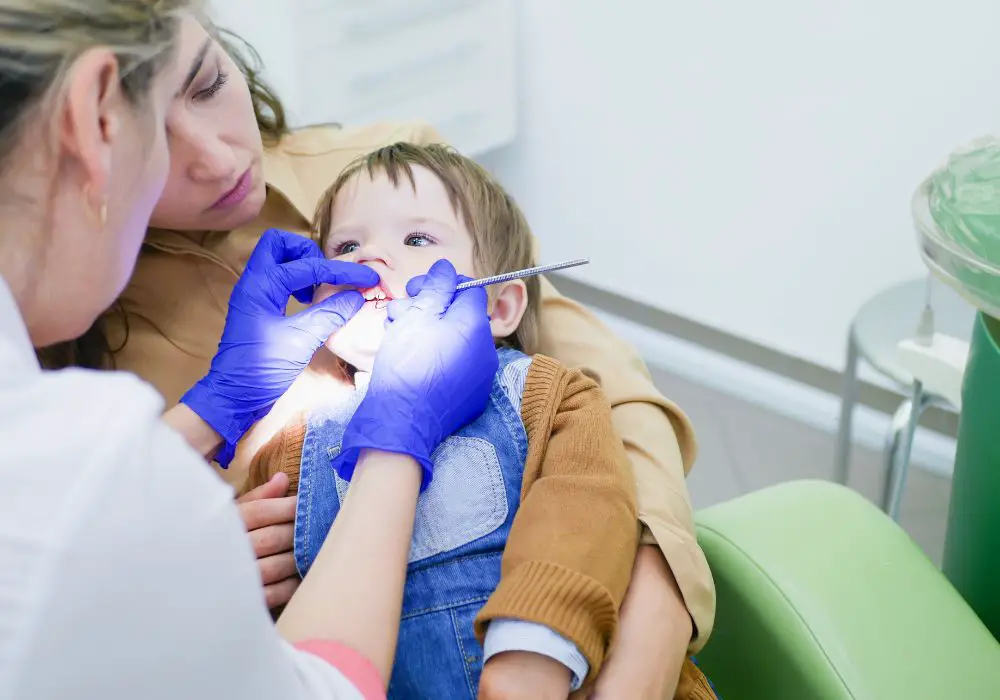
It is recommended to take your baby to a pediatric dentist within six months of the first tooth coming in or by about 12 months at the latest. However, there are certain situations where you should consult a pediatric dentist even earlier. Here are some signs that indicate it’s time to schedule an appointment with a pediatric dentist:
Delayed Tooth Eruption
If your baby is over 12 months old and hasn’t had any teeth come in yet, it’s time to consult with a pediatric dentist. Delayed tooth eruption can be a sign of an underlying issue that needs to be addressed.
Discoloration or Spots on Teeth
If you notice any discoloration or spots on your baby’s teeth, it’s important to consult with a pediatric dentist. These could be signs of tooth decay or other dental issues that need to be addressed as soon as possible.
Tooth Pain or Sensitivity
If your baby is experiencing tooth pain or sensitivity, it’s important to consult with a pediatric dentist. This could be a sign of tooth decay, infection, or other dental issues that need to be treated promptly.
Difficulty Eating or Chewing
If your baby is having difficulty eating or chewing, it could be a sign of dental issues. Consult with a pediatric dentist to rule out any underlying dental problems that could be causing the issue.
Unusual Oral Habits
If your baby has any unusual oral habits, such as thumb-sucking or tongue-thrusting, it’s important to consult with a pediatric dentist. These habits can cause dental issues if they persist for too long.
In general, it’s best to consult with a pediatric dentist as soon as you notice any issues with your baby’s teeth or oral health. Early intervention can prevent more serious dental issues from developing in the future.
Frequently Asked Questions
What are some remedies for teething discomfort in babies?
Teething can cause discomfort and irritability in babies. Some remedies that may help alleviate the discomfort include using a clean finger or a cold teething ring to gently massage the baby’s gums, giving the baby a cold washcloth or spoon to chew on, or using over-the-counter pain relievers such as acetaminophen or ibuprofen (for babies over 6 months old).
How can you tell if your baby’s gums are teething gums?
Teething gums may appear swollen and red, and you may be able to feel the baby’s teeth underneath the gum line. Some babies may drool more than usual or seem more irritable than usual.
What is the typical timeline for baby teeth to erupt?
Most babies will start to get their first teeth between 4 and 7 months old, with the two bottom front teeth (central incisors) usually appearing first. By the age of 3, most children will have a full set of 20 primary teeth.
Is it normal for a baby’s side teeth to come in before the front teeth?
Yes, it is normal for a baby’s side teeth (lateral incisors) to come in before the front teeth. The order in which baby teeth come in can vary from child to child.
What are some symptoms of teething in babies?
Some common symptoms of teething in babies include drooling, irritability, biting or chewing on objects, swollen or red gums, and a slight increase in body temperature.
Are there reasons why a baby may start teething early?
In some cases, babies may start teething earlier than usual due to genetics or other factors. Certain medical conditions or medications may also cause early teething. If you have concerns about your baby’s teething, it’s best to consult with a healthcare provider.


